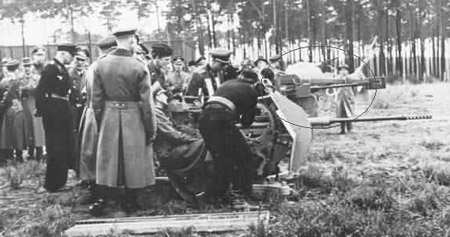Kummersdorf

Fig 1. An artillery test at Kummersdorf.

Fig 2. Hitler watches a demonstration at Kummersdorf in March 1939.
Kummersdorf is an estate, 25 km south of Berlin, part of which was used from 1875 as an artillery range, initially by the Prussian military and later by the German Army. It played an important role in the pre-war development of rocketry.
In the early 1930s, the Verein für Raumschiffahrt (VfR), which had designed and tested a number of early liquid-fueled rockets at its Berlin launching site, Raketenflugplatz, sought support from the Germany army to further its work. After a demonstration flight of a Repulsor rocket in the summer of 1932, the army invited Wernher von Braunto do the experimental work for his doctor's thesis on rocket combustion phenomena at Kummersdorf.
At Kummersdorf the army continued experiements under the direction of Captain Walter Dornberger and von Braun. The Heereswaffenamt-Prüfwesen (Army Ordnance Research and Development Department) gradually developed the Versuchsstelle Kummersdorf–West as a site for developing and static-testing rockets. Between November 1932, when von Braun began work on his thesis with the help of a single mechanic, and 1937, when the Kummersdorf–West staff had grown to about eighty, the group worked on several small rockets. This work laid the groundwork for the V-2.
The main source of support within the army for the Kummersdorf project was Artillery General Karl Becker, who, with his mentor Carl Cranz of the Pru-sian Academy for Military Engineering, had long championed the rocket as an artillery weapon. The Cranz-Becker textbook, Ballistics, contained a chapter on the subject, ample evidence of the authors' thinking on the potential of the rocket. It was Becker who encouraged and sponsored von Braun's doctoral thesis and, after his graduation, put him to work in the army under Major von Horstig and his assistant, Captain Dornberger. And it was Becker who, in 1935, proposed in vain to Hitler a program to develop a long-range bombardment rocket.
The first new rocket to be developed at Kummersdorf was the A-1, an abbreviation for Aggregate 1 (see A series). Powered by an alcohol–liquid oxygen regeneratively cooled engine developing 660 pounds of thrust, the A-1 was a relatively simple rocket. The alcohol-cooled engine was in the bottom bulkhead of the single pressurized metal tank which was half filled with alcohol. While the alcohol fuel filled the lower half of the metal tank, liquid oxygen was loaded into a thin-walled, open fiberglass container inserted into the upper half of the metal tank. A small compressed-nitrogen flask, pressurizing the single metal tank, thus provided identical feed pressure for both propellants. The payload was a 70-pound gyroscopic flywheel in the rocket's nose, which provided stability during the 16-second powered flight.
After a few successful static tests, the first A-1 was destroyed by an explosion caused by delayed ignition. Model tests had shown, meanwhile, that the flywheel had to be closer to the rocket's center to be effective. Since the location of the open oxygen container within the fuel tank posed the danger of a flashback explosion after a powered flight, the arrangement was changed. The fuel tank was shortened, a separate metal tank was provided for the liquid oxygen, and the gyrowheel was placed between the two tanks. The new configuration was called A-2. In December 1934 on the North Sea island of Borkum, two A-2 rockets, "Max" and "Moritz" – named after characters in a humorous German book – made two successful straight-up flights to altitudes of about 6,500 feet.
The Borkum success was a shot in the arm for Kummersdorff. The staff was increased and allotted more funds. The Dornberger-von Braun organization grew, as did the power of the rocket engines. By the late 1930s, it had become clear the site was too small and congested for the kinds of tests that were needed. The staff at Kummersdorf already numbered around 80 and more engineers and laborers were needed. A new site was sought on the coast from which rockets could be safely launched, tracked and/or recovered during testing, and which was also secure and secret. The Luftwaffe, too, had decided to invest funds in rocket research and soon a joint operation with the German Army resulted in the selection of the small fishing village of Peenemünde on the Baltic coast.
Reference
Von Braun, Wernher, and Frederick Ira Ordway. History of Rocketry & Space Travel. New York: Crowell, 1966.


